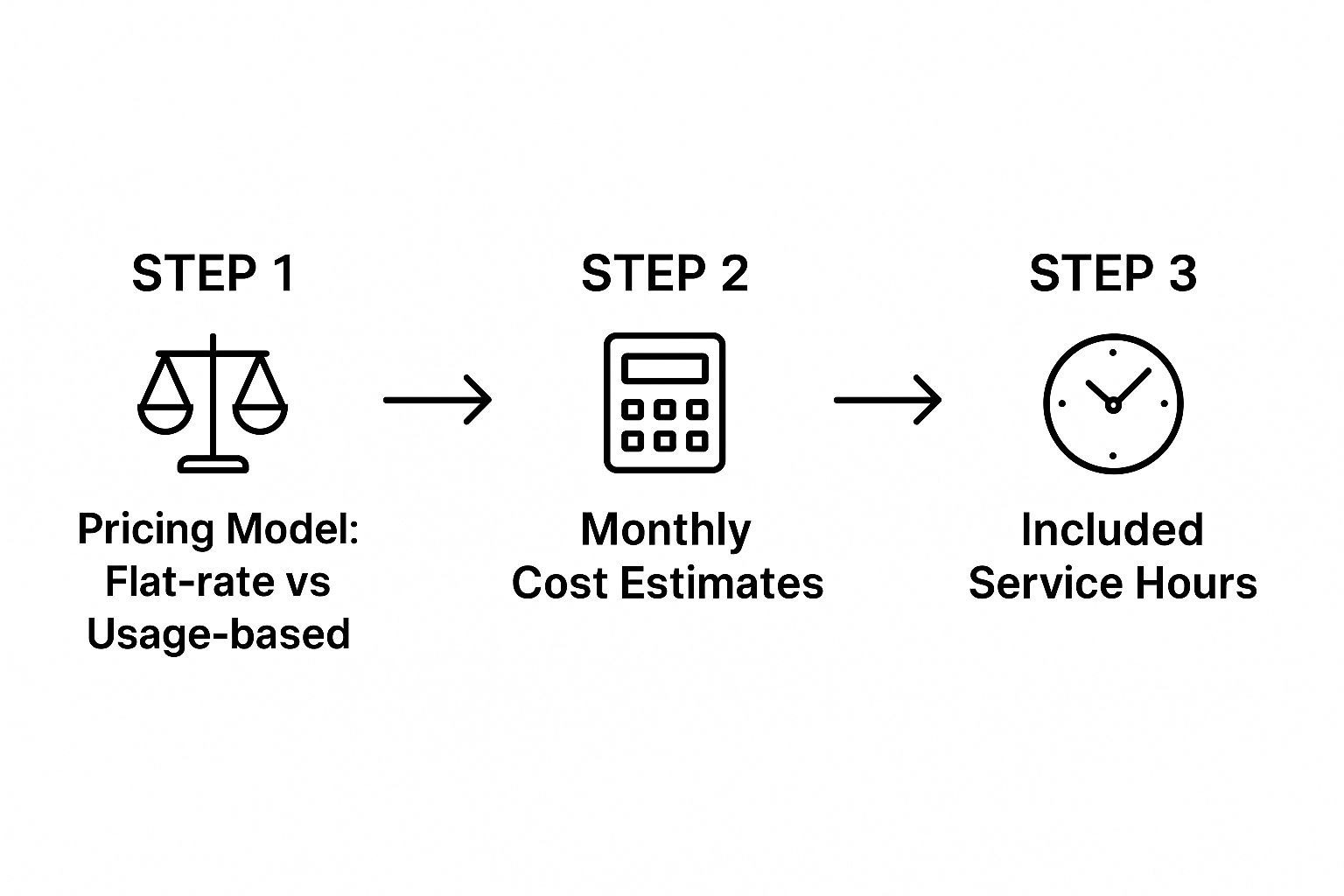Picking the right Managed Service Provider (MSP) is a lot more than just handing off your IT problems. You’re not just outsourcing support; you’re bringing a strategic partner into the fold who needs to be perfectly aligned with your business goals.
The whole process really comes down to a few key stages: defining what you actually need, digging into a vendor’s technical skills and security chops, scrutinizing their support models, and making sure they have real, in-the-trenches experience in your industry. Get this right, and technology stops being a headache and starts being a competitive advantage.
Why Choosing an MSP Is a Critical Business Decision
If you’re staring at an increasingly complex IT landscape, you’re in good company. Deciding to work with an MSP is no longer just a simple cost-cutting move; it’s become a core business strategy. For industries like hospitality, multi-family housing, and senior living, technology isn’t just humming in the background anymore—it directly shapes resident satisfaction, operational efficiency, and your overall security posture.
This is especially true as IT environments get more tangled. The pressure for constant uptime, rock-solid cybersecurity, and smooth integration of new tech is relentless. Trying to manage all of this in-house means a huge investment in specialized staff, non-stop training, and pricey tools. For most businesses, that’s just not realistic. An MSP gives you a way to tap into enterprise-level expertise without the massive overhead.
The market statistics tell the same story. The global MSP market hit around $279 billion in 2024 and is expected to rocket to $572 billion by 2033. This boom is a direct result of businesses needing expert, scalable solutions for their technology. You can dive deeper into the market trends and what’s driving them if you’re curious.
Beyond IT Support to Strategic Partnership
The best MSP relationships go far beyond a simple break-fix contract. A true partner doesn’t just wait for trouble tickets to roll in. They work proactively to head off problems before they start and help align your technology with your long-term vision.
The goal is to get out of a reactive state—where you’re constantly putting out fires—and into a proactive one, where your technology actively drives growth, tightens security, and improves the experience for your guests or residents.
Think about these crucial shifts in mindset:
- From Cost Center to Value Driver: A top-tier MSP helps you turn the IT budget into an investment that actually improves your net operating income (NOI) and keeps customers happy.
- From Vendor to Partner: They should intimately understand the unique pressures of your world, whether that’s delivering bulletproof Wi-Fi for hotel guests or maintaining HIPAA compliance in a senior living facility.
- From Technician to Strategist: Your MSP should be at the table with you, providing a clear technology roadmap, advising on future upgrades, and helping you stay ahead of the curve.
Ultimately, how you choose a managed service provider will determine whether your technology becomes a powerful asset or a constant liability. This guide is built to cut through the jargon and give you a practical roadmap, so you can pick a partner you genuinely trust to help your business thrive.
Defining Your Real-World IT Needs and Goals

Before you pick up the phone to call a single provider, the most important work happens right inside your own walls. A successful search for a managed service provider (MSP) always starts with a brutally honest look at your own operations. This isn’t just about tech; it’s a full-on business reality check.
You’ve got to dig deeper than “the Wi-Fi is slow.” What’s the real, tangible impact of that slowness? Are you a hotel getting slammed with negative reviews because the internet is spotty on the fifth floor? Or maybe you run a senior living facility, and a network vulnerability is putting sensitive resident health information at risk.
When you connect these tech frustrations to actual business outcomes—lost revenue, bad reviews, compliance fines—you start to build a rock-solid case for what you truly need. This clarity is your secret weapon for cutting through the noise and finding a partner who gets it, instead of one selling a one-size-fits-all package.
From Pain Points to Business Goals
The next step is to translate those problems into a detailed requirements document. Think of this as your North Star for the entire selection process. This isn’t a simple tech wish list; it’s a strategic blueprint connecting every IT requirement back to a core business goal.
Start by drawing a clear line from your current headaches to your desired future state.
Here’s what I mean:
- Hospitality Example: Your front desk team is constantly fighting a sluggish Property Management System (PMS) during peak check-in. The business goal is to cut guest check-in times by 25% and boost those crucial satisfaction scores. The IT requirement then becomes a network infrastructure that guarantees unwavering, high-speed performance for your most critical apps, no matter how busy you get.
- Senior Living Example: You’re expanding the facility and need to ensure every new resident has flawless access to telehealth appointments and video calls with family. The business goal is to enhance resident well-being and stay ahead of the competition. This translates to an IT requirement for a scalable, secure, and HIPAA-compliant network that can handle a growing number of medical devices and personal gadgets.
This simple exercise changes the entire conversation. You stop saying, “We need faster internet,” and start saying, “We need a network that directly supports our revenue and operational goals.”
A clear, detailed requirements document is the single most valuable asset you can create. It ensures you’re buying a solution to a business problem, not just a list of tech specs. It also holds both you and your future MSP accountable to specific, measurable results.
Building Your Requirements Document
Don’t let this feel like a monumental task. A simple framework is all you need, something that people from operations, finance, and even marketing can easily understand and contribute to.
Get the right people in a room and start hashing out the answers to a few key questions:
- What are our top 3-5 operational bottlenecks that are clearly caused by technology?
- Where do our biggest security or compliance risks live right now?
- Looking ahead 1-3 years, what are our growth plans, and what tech will we need to make them happen?
- How does our technology impact the guest or resident experience today—for better or for worse?
Once you have the answers, organize them into practical categories. Think in terms of Network Performance, Cybersecurity, Compliance (HIPAA, PCI DSS), Scalability, and User Support.
Get specific. “Better security” is vague. “Implement multi-factor authentication for all staff and create a fully isolated, secure guest network” is an actionable requirement.
This internal deep-dive is the essential groundwork. It equips you to ask smarter questions, evaluate proposals with confidence, and ultimately choose a managed service provider that will not only fix today’s problems but also help you build for tomorrow.
Evaluating Technical Expertise and Industry Fit

Any MSP can put together a flashy website with an impressive wall of logos. That’s the easy part. The real challenge is finding a partner with proven technical chops and a genuine understanding of your specific industry. This is where you have to cut through the sales pitch and find out if they truly get what makes your business tick.
A generic IT provider might be great at fixing a printer, but they won’t grasp the unique pressures you face every day. Someone with deep hospitality experience, for instance, knows that a Wi-Fi outage during a sold-out weekend isn’t just an inconvenience. It’s a full-blown crisis that tanks revenue and lights up review sites with one-star ratings.
Similarly, an MSP that works with senior living communities recognizes that HIPAA compliance is more than just a box to check. It’s a foundational requirement that has to be baked into every single network and security decision.
Look Beyond the Logo Wall
So, how do you verify their expertise? You need to dig into their team’s technical certifications and, more importantly, their hands-on experience. Don’t be afraid to ask for specifics. A provider’s team should hold current, relevant certifications from the major vendors that power your technology stack.
Look for credentials that actually matter to your operations:
- Networking: Certifications from vendors like Cisco (think CCNA or CCNP) or Aruba prove they can build and manage the kind of robust, high-performance networks your properties depend on.
- Cloud Services: If you’re using or moving to the cloud, expertise with platforms like Microsoft Azure or Amazon Web Services (AWS) is non-negotiable.
- Security: Look for credentials like CompTIA Security+ or CISSP. These show a serious commitment to protecting your sensitive data and infrastructure from threats.
These certifications aren’t just fancy acronyms on a resume; they represent a verifiable standard of knowledge and show that the MSP invests in keeping their team’s skills sharp.
The right question isn’t “Do you have experience in our industry?” Instead, ask: “Can you share an example of how you solved a problem for another hotel/senior living facility/commercial property that’s similar to ours?” This forces them to move beyond vague claims and into real-world application.
From Reactive Fixes to Proactive Strategy
One of the biggest differentiators when you choose a managed service provider is their core philosophy. Are they a reactive “break-fix” shop that just waits for your panicked call, or do they operate proactively to stop problems before they ever disrupt your business? The answer often lies in their Network Operations Center (NOC).
Ask them directly about their NOC. How do they monitor your systems? What kinds of alerts do they have in place? A mature MSP will use sophisticated tools to keep a 24/7 watch over your network, identifying potential failures—like a dying switch or a failing server drive—long before you even know there’s an issue.
This forward-thinking approach is critical as technology gets more complex. The hospitality and commercial sectors are seeing huge growth in the adoption of Internet of Things (IoT) devices and a much greater reliance on data analytics. Top-tier MSPs are already investing heavily in AI-driven tools to manage these complex ecosystems and the risks that come with them. As you evaluate potential partners, you have to assess their ability to handle these emerging technologies. You can get more insight into how AI and IoT are reshaping the managed services market on PR Newswire.
Ultimately, you’re not just hiring a technician; you’re looking for a partner who speaks your language—not just technically, but commercially. They need to understand your operational pace, your regulatory hurdles, and what it really takes to keep your guests or residents happy. This blend of technical skill and deep industry fit is the bedrock of a successful MSP relationship.
Assessing Security Posture And Compliance Know-How
When you’re vetting a potential managed service provider, a weak security stance should be an immediate deal-breaker. It’s not enough for them to just say they offer “cybersecurity services.” You need to get into the weeds and find out exactly how they plan to protect your business, your data, and your hard-earned reputation.
A great place to start is their Security Operations Center (SOC). A real SOC isn’t just a room with a bunch of monitors; it’s a dedicated team armed with battle-tested processes for threat hunting, detection, and rapid response. Don’t hesitate to ask some tough questions. What exactly happens if they find ransomware on your network at 2 AM on a Saturday?
Their answer should be confident, detailed, and rehearsed. If you get a vague, hand-wavy response, consider it a massive red flag.
Scrutinizing The Security Stack
Beyond how they react to a crisis, you need to understand the tools and policies they use every day. A truly mature MSP will have a standardized, robust security stack they deploy for every single client. This is about much more than just antivirus software; it’s about a defense-in-depth strategy.
Here are a few key areas to probe:
- Data Encryption: How is your data protected, both when it’s moving across the network and when it’s stored on a server? Any sensitive information, especially guest or resident data, must be encrypted using current, strong standards.
- Access Control: What kind of identity and access management do they enforce? Things like multi-factor authentication (MFA) should be mandatory for both their team and yours when accessing critical systems.
- Proactive Monitoring: Are they actively hunting for threats or just waiting for an alarm to go off? Ask them about the tools they use for vulnerability scanning and continuous network monitoring.
Getting a full picture of their security methodology is critical. For more pointed questions to ask, our guide on how to choose managed IT security services provides a more detailed checklist.
In today’s world, cybersecurity can’t be an optional add-on from your MSP—it has to be a core part of their service. A provider’s own security posture is a direct reflection of their ability to actually protect your business.
The infographic below gives a high-level view of evaluating an MSP’s core deliverables, but remember, these services are only as good as the security foundation they’re built on.

While this process helps clarify the financial and service commitments, none of it matters without rock-solid security and compliance guarantees to back it up.
Verifying Compliance Experience
For businesses in hospitality, senior living, and commercial real estate, regulatory compliance is simply not negotiable. Your MSP must have provable, hands-on experience with the specific regulations that govern your industry. Theoretical knowledge just doesn’t cut it.
There’s a world of difference between a provider who claims they “can handle” HIPAA and one who can actually show you how they’ve designed and maintained HIPAA-compliant networks for other senior living communities. The same goes for PCI DSS in a hotel that processes credit cards. Ask them for case studies or redacted project plans from businesses with compliance needs just like yours.
To give you a structured way to approach these conversations, we’ve put together a checklist. Use this to guide your questions and evaluate the answers you get from potential partners.
MSP Vetting Checklist: Security and Compliance
| Evaluation Area | Key Questions to Ask | Ideal Response or Red Flag |
|---|---|---|
| Incident Response | “Walk me through your exact process for a major security breach, from detection to resolution.” | Ideal: A detailed, step-by-step plan. Red Flag: Vague answers or “We’ll figure it out.” |
| Security Stack | “What specific security tools are standard in your service package? (e.g., EDR, MFA, firewall)” | Ideal: A layered stack with specific brand names. Red Flag: “We use standard antivirus.” |
| Compliance Expertise | “Can you provide examples of how you’ve helped clients like us meet [HIPAA/PCI DSS/etc.] requirements?” | Ideal: Specific case studies or anonymized examples. Red Flag: “We’re familiar with it.” |
| Staff Training | “How do you ensure your own technicians are up-to-date on the latest security threats and protocols?” | Ideal: Mentions of ongoing certifications, regular training, and phishing tests. Red Flag: No formal training process. |
| Data Handling | “Where will our data be stored, and how is it encrypted both at rest and in transit?” | Ideal: Clear information on data center locations and encryption standards (e.g., AES-256). Red Flag: Unsure or evasive. |
This checklist is a starting point. A truly capable MSP will welcome these questions and have impressive answers ready.
The modern IT environment is far too complex to leave to chance. According to recent MSP trends from Canalys.com, businesses are increasingly prioritizing providers with deep security, cloud, and industry-specific compliance skills. At the end of the day, an MSP that can’t prove its security and compliance expertise is a risk you simply can’t afford to take.
Making Sense of SLAs and Support Models

You’ve sat through the presentations and heard all the sales pitches. Now comes the moment of truth: digging into the Service Level Agreement (SLA). This isn’t just another contract; it’s the operational heart of your partnership with an MSP. This is where promises are put into writing, and learning to decode it is one of the most critical steps when you choose a managed service provider.
A solid SLA should provide a crystal-clear, measurable framework for performance. If the language feels fluffy or vague, that’s a serious red flag. Trust me, ambiguous terms almost always protect the provider, not the client.
Think of the SLA as your primary tool for accountability. It’s where you collaboratively define what success looks like and, just as importantly, what happens when those expectations aren’t met.
Decoding Key SLA Metrics
Don’t let yourself get bogged down in pages of dense legal jargon. Your focus should be on the metrics that directly impact your day-to-day operations and guest experience. A great SLA is specific and quantifiable, leaving zero room for doubt.
Here are the key metrics you need to scrutinize:
- Guaranteed Uptime: This is usually presented as a percentage, like 99.9% uptime. But you have to ask: what exactly does this cover? Is it just network connectivity, or does it include business-critical applications like your Property Management System (PMS) or point-of-sale terminals? The difference is huge.
- Response Time: This is simply how quickly the provider promises to acknowledge your support request. It’s not the same as fixing the problem. A 15-minute response time means very little if the issue isn’t actually resolved for hours.
- Resolution Time: This is the metric that truly matters. How long does it take to fix the problem? Look for tiered resolution targets based on issue severity. A critical system outage should have a much more aggressive resolution guarantee than a single user’s printer problem.
The real teeth of any SLA lie in the penalty clause. If a provider misses their uptime or resolution guarantees, what are the consequences? A well-written agreement will clearly spell out service credits or other financial rebates for non-compliance. Without this, the SLA is just a list of polite suggestions.
Beyond the Contract to Real-World Support
An SLA is just one piece of the puzzle. You also need a deep understanding of the provider’s actual, day-to-day support model and how it aligns with your operational reality. For any hospitality or senior living business, an issue at 8 PM on a Saturday is just as urgent as one at 10 AM on a Tuesday.
Let’s play out a scenario. It’s 7 PM on a Friday, your hotel lobby is packed, and the front desk system goes down during peak check-in. Guests are getting impatient, your staff is overwhelmed, and your online reputation is taking a hit with every passing minute. This is the moment when the true quality of your MSP’s support model becomes painfully clear.
To avoid that nightmare, ask these practical questions before you sign:
- What are the real support hours? Is it genuine 24/7/365 support staffed by qualified technicians, or does “after-hours support” just roll over to a basic answering service that creates a ticket for the morning?
- What does the escalation path look like? If the first-level tech can’t solve your critical issue, how quickly does it get to a senior engineer who can? When a major system failure is costing you money by the minute, you need to know exactly who to call.
- How is support actually delivered? Do they offer phone, email, and live chat? Is there a client portal where you can track the status of your tickets in real time?
Understanding the different service tiers they offer is also essential. Our guide on choosing the best managed IT service plans can help you compare packages to find a plan that fits both your budget and your non-negotiable support needs. At the end of the day, the right combination of a strong SLA and a responsive, real-world support structure is what will save your business when things inevitably go wrong.
Final Steps for Choosing Your MSP Partner
You’ve done the heavy lifting. The tech stack has been scrutinized, security protocols have been questioned, and the fine print on the SLAs has been decoded. Now comes the moment of truth: making the final call. This stage is less about the hardware and software and more about the human side of the partnership.
First things first: check their references. But don’t just accept the hand-picked list of their happiest customers. Insist on speaking with a business that looks a lot like yours in terms of size and industry. Better yet, ask if you can talk to a client who’s weathered a major crisis with them. That’s where you’ll get the real, unvarnished story.
Probing for Real-World Performance
When you get a reference on the phone, move past the generic, “So, are you happy with them?” You need to dig in to find out how they perform when the pressure is on.
Try asking more pointed questions:
- “Tell me about a time they had to resolve a critical issue for you. How did they communicate with you while it was happening?”
- “Have you run into any unexpected costs or hidden fees that weren’t obvious in the initial contract?”
- “How proactive are they? Are they bringing new ideas to the table, or do they just show up when something breaks?”
The answers you get here will speak volumes and tell you more than any polished sales pitch ever will.
A provider’s culture and communication style are just as critical as their technical abilities. A team of tech geniuses who can’t communicate clearly during a crisis or understand your business goals is simply the wrong partner.
The Final Contract Review
Before you sign anything, it’s time for one last, careful look at the contract and proposal. Your goal here is to understand the Total Cost of Ownership (TCO), which is almost always more than just the monthly fee.
Be on the lookout for clauses about out-of-scope projects, markups on hardware, and any potential fees for onboarding or even ending the contract. A transparent partner will be completely upfront about these costs, so there are no nasty surprises waiting for you. If you need a bit more guidance on this, our guide to finding the perfect managed IT provider for your needs can help you nail down these final questions.
Ultimately, this last phase is about making sure the MSP isn’t just another vendor, but a true partner invested in your success. By digging into references, getting a feel for their communication, and understanding the full financial picture, you can confidently choose a managed service provider who will be there to support your business for the long haul.
Got Last-Minute Questions? Let’s Get Them Answered
As you get closer to picking a technology partner, a few practical questions always seem to pop up. This is a good thing. Getting straight answers before you sign on the dotted line is the best way to make sure there are no surprises down the road and that you feel completely confident in your choice.
Here are some of the most common questions we hear from decision-makers right before they choose a managed service provider.
How Do MSPs Typically Structure Their Pricing?
You’ll find that MSP pricing isn’t a simple, one-size-fits-all deal. Most providers use one of a few common models: per-user, per-device, or tiered service bundles. For businesses where one person uses a laptop, a tablet, and a smartphone, the per-user model often provides the most predictable and straightforward billing.
When you’re comparing quotes, you have to look past the monthly number and dig into the total value. A rock-bottom price might look great at first, but it can quickly get expensive if you’re constantly hit with out-of-scope project fees or suffer costly downtime.
Don’t just compare prices; compare outcomes. You need to ask what’s explicitly covered in the Service Level Agreement (SLA). Is project work extra? What’s their role during a major incident? A slightly higher monthly fee for a truly comprehensive plan is almost always a smarter investment.
How Important Is It That They Know My Industry?
Honestly, it’s critical. An MSP that already knows the ins and outs of your world—whether that’s hospitality, senior living, or commercial real estate—brings so much more to the partnership than just generic IT support. They come in on day one with an ingrained understanding of your operational headaches, your specific compliance needs (like HIPAA or PCI DSS), and the niche software you rely on to run your business.
This specialized experience translates directly into faster, more relevant support. You won’t have to waste time giving them a crash course on why your Property Management System is the lifeblood of your operation. They already get it. Better yet, they can suggest technology solutions that actually make sense for your business, not just what’s popular in the tech world.
What Does a Good Onboarding Process Actually Involve?
A professional MSP won’t just “wing it.” They should present you with a clear, structured onboarding plan. This process should always kick off with a deep-dive discovery phase where they meticulously audit your entire existing IT environment.
From there, they should deliver a strategic implementation plan and a technology roadmap. A dedicated project manager is non-negotiable; they are your single point of contact, ensuring the whole transition is smooth, communication is constant, and disruption to your team is minimal. Before you even think about signing, ask them to walk you through a detailed onboarding timeline so you know exactly what to expect and when.
How Can I Check References the Right Way?
When you get on the phone with an MSP’s current clients, you need to probe deeper than a simple, “So, are you happy with them?” To get the real story, you need to ask targeted, situational questions.
Give these a try:
- “Could you walk me through a time they solved a really critical issue for you?”
- “What’s their communication like when a system goes down?”
- “Have you ever been hit with unexpected costs or fees that weren’t in the contract?”
If you can, try to speak with a reference from a company in an industry similar to yours. Their experience will give you the most accurate preview of what your own partnership will feel like.
Ready to partner with a managed service provider that understands your industry’s unique demands? Clouddle Inc delivers integrated security, networking, and IT solutions tailored for hospitality, multi-family, and senior living. Discover how our end-to-end services can boost your NOI and resident satisfaction.


